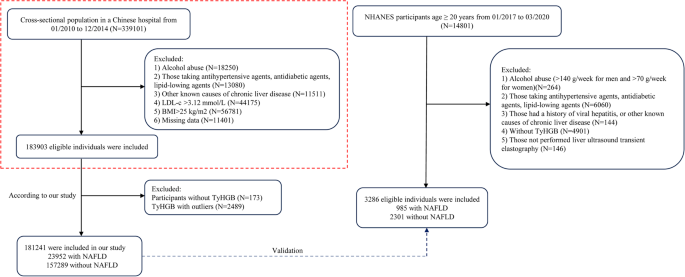Report on a Retrospective Investigation into Non-Alcoholic Fatty Liver Disease (NAFLD)
Contribution to Sustainable Development Goal 3: Good Health and Well-being
This report details a retrospective investigation designed to enhance the understanding of Non-alcoholic Fatty Liver Disease (NAFLD), a critical non-communicable disease. The study’s methodology and findings directly support the United Nations Sustainable Development Goal 3 (SDG 3), particularly Target 3.4, which aims to reduce premature mortality from non-communicable diseases through prevention and treatment. By investigating metabolic markers associated with NAFLD, this research contributes to the global effort to promote health and well-being for all ages.
Methodology and Data Sources
Study Design and Participant Cohorts
The investigation utilized a retrospective design, drawing upon two distinct and extensive databases to ensure robust and generalizable findings. This approach aligns with SDG 9 (Industry, Innovation, and Infrastructure) by leveraging large-scale data infrastructure for scientific research.
- Primary Cohort: Data was sourced from a hospital-based health screening database at the Wenzhou Medical Center, Wenzhou People’s Hospital, China, covering the period from January 2010 to December 2014. An initial pool of 181,241 adult participants was considered.
- Validation Cohort: To validate findings in a diverse population, data from the 2017–2018 cycle of the National Health and Nutrition Examination Survey (NHANES) in the United States was analyzed. This cohort included 3,286 adult participants with complete relevant data.
The use of publicly available data from the DATADRYAD and NHANES databases exemplifies a commitment to SDG 17 (Partnerships for the Goals) by promoting data sharing and collaborative research.
Participant Selection and Ethical Standards
A systematic selection process was applied to both cohorts to ensure data integrity and relevance. The ethical conduct of this research is paramount, reflecting principles of responsible science.
Exclusion Criteria
Participants were excluded based on the following criteria to isolate NAFLD from other confounding factors:
- Significant alcohol consumption (>140 g/week for males, >70 g/week for females in the Chinese cohort; >3 drinks/day for males, >2 drinks/day for females in the NHANES cohort).
- Presence of other chronic liver diseases (e.g., viral hepatitis, autoimmune hepatitis).
- Use of medications known to influence hepatic steatosis or metabolic parameters.
- Incomplete data required for calculating key indices (TyHGB, TyG).
- Missing liver ultrasonography results.
Ethical Approvals and Confidentiality
Adherence to ethical guidelines was strictly maintained. The research protocol received ethics approval from the Wenzhou People’s Hospital Ethics Committee and the National Center for Health Statistics Research Ethics Review Board for the NHANES protocols. Informed consent was obtained from all participants. To ensure confidentiality, personal identifiers were removed and replaced with anonymized health examination numbers.
Diagnostic and Data Collection Procedures
Ultrasonographic Diagnosis of NAFLD
Accurate diagnosis is fundamental to public health surveillance and achieving SDG 3. Standardized methods were employed for NAFLD assessment in both cohorts.
- Chinese Cohort: Diagnosis was established via ultrasonographic evaluation by qualified technicians, following guidelines from the Chinese Liver Disease Association. NAFLD was identified by characteristic features such as diffuse echogenicity, with consensus required from at least two experienced ultrasonographers.
- NHANES Cohort: Hepatic steatosis was assessed using transient elastography (FibroScan). NAFLD was defined by a controlled attenuation parameter (CAP) score of ≥248 dB/m in the absence of other known causes of liver disease.
Collection of Covariates
Comprehensive data collection allows for a multi-faceted analysis of health determinants, which is essential for developing effective public health strategies.
Chinese Hospital Cohort Data
- Demographic and Anthropometric: Age, sex, weight, height, and Body Mass Index (BMI).
- Clinical: Blood pressure.
- Biochemical: A full panel of liver function tests (ALT, AST, GGT), kidney function tests (urea nitrogen, creatinine, uric acid), lipid profiles (TC, TG, HDL-C, LDL-C), and fasting blood glucose (FBG).
NHANES Cohort Data
- Demographic and Socioeconomic: Age, sex, race/ethnicity, education, marital status, and income.
- Anthropometric: Waist circumference and BMI.
- Clinical: History of cardiovascular disease (CVD), diabetes, hypertension, and smoking status.
- Biochemical: Liver enzymes (ALT, AST), lipid profile, FBG, and glycated hemoglobin (HbA1c).
The TyHGB index was calculated as TG/HDL-C + 0.7*FBG (mmol/L) + 0.1*BMI (kg/m²), and the TyG index was calculated as ln[TG (mg/dL) × FBG (mg/dL)/2].
Statistical Analysis Framework
Advancing Evidence-Based Health Policy through Rigorous Analysis
A robust statistical framework was employed to ensure the reliability and validity of the findings, contributing to the body of scientific knowledge needed to guide health policies under SDG 3. This rigorous approach is an application of SDG 9’s focus on enhancing scientific research and innovation.
Data Handling and Preliminary Analysis
- Continuous variables were described using mean ± standard deviation or median [interquartile range], while categorical data were presented as frequency (percentage).
- The Kruskal-Wallis test, one-way ANOVA, and chi-square tests were used to evaluate baseline characteristics.
- Missing data were addressed using k-nearest neighbor (KNN) imputation.
- Multicollinearity was assessed using the variance inflation factor (VIF).
Modeling and Performance Evaluation
- Association Analysis: Multivariable logistic regression models were used to calculate odds ratios (ORs) and 95% confidence intervals (CIs) for the association between TyHGB and NAFLD, with three stepwise adjustment models to control for covariates.
- Nonlinear Relationship: Restricted cubic spline (RCS) modeling was conducted to investigate potential nonlinear associations.
- Predictive Performance: Receiver operating characteristic (ROC) curve analysis was used to calculate the area under the curve (AUC). DeLong’s test compared the AUCs of the TyHGB and TyG indices.
- Incremental Value Assessment: Net reclassification improvement (NRI) and integrated discrimination improvement (IDI) were calculated to quantify the added value of the TyHGB index over baseline models.
All analyses were performed using R software and EmpowerStats, with statistical significance set at P < 0.05.
Analysis of Sustainable Development Goals in the Article
1. Which SDGs are addressed or connected to the issues highlighted in the article?
-
SDG 3: Good Health and Well-being
The article is a medical research study focused on Non-alcoholic fatty liver disease (NAFLD), a non-communicable disease (NCD). By investigating metabolic markers and developing a new predictive index (TyHGB), the study directly contributes to the broader goal of understanding, preventing, and managing NCDs to ensure healthy lives and promote well-being.
-
SDG 9: Industry, Innovation, and Infrastructure
The research is an example of scientific innovation. It relies on advanced technological infrastructure for data collection and diagnosis, such as “liver ultrasonography,” “transient elastography via FibroScan,” and “automated analyzer (Abbott AxSYM).” The development and statistical validation of a new index represent an enhancement of scientific research capabilities.
-
SDG 17: Partnerships for the Goals
The study’s methodology involves using data from two different large-scale sources: a hospital database in China and the public National Health and Nutrition Examination Survey (NHANES) database from the United States. This demonstrates the use of data partnerships and highlights the importance of high-quality, reliable, and disaggregated data for achieving sustainable development goals.
2. What specific targets under those SDGs can be identified based on the article’s content?
-
Target 3.4: Reduce premature mortality from non-communicable diseases
The article’s focus on improving the prediction of NAFLD directly supports this target. NAFLD is a leading cause of chronic liver disease and is associated with other NCDs like diabetes and cardiovascular disease. Better early detection, as proposed by the study, is a critical step toward prevention and treatment, which can ultimately reduce premature mortality from these diseases.
-
Target 3.d: Strengthen the capacity for early warning, risk reduction and management of health risks
The development and validation of the TyHGB index as a predictive tool for NAFLD is a direct contribution to strengthening the capacity for early warning and risk reduction. By providing a more accurate marker, the research helps in identifying at-risk individuals more effectively, allowing for better management of this national and global health risk.
-
Target 9.5: Enhance scientific research and encourage innovation
This article is a tangible outcome of scientific research. It not only uses existing technology but also innovates by creating a new predictive model (TyHGB index) and employing advanced statistical methods like “multivariable logistic regression models” and “restricted cubic spline (RCS) modeling” to validate its findings. This contributes to the global body of scientific knowledge.
-
Target 17.18: Enhance capacity-building support to increase the availability of high-quality, timely and reliable data disaggregated by key characteristics
The study is fundamentally based on the availability of such data. The article explicitly details the collection of data disaggregated by “age and sex” in the Chinese cohort, and by “age, sex (male, female), and race/ethnicity,” “education achievement,” “marital status,” and “household income” in the NHANES cohort. This demonstrates the value and application of comprehensive, disaggregated data in health research.
3. Are there any indicators mentioned or implied in the article that can be used to measure progress towards the identified targets?
-
Indicators for SDG 3 (Good Health and Well-being)
The article implies several indicators that can measure progress in combating NCDs:
- Prevalence of NAFLD: The study’s objective is to identify NAFLD in large populations, making its prevalence a key health indicator.
- Levels of metabolic markers: The article measures and analyzes numerous biochemical markers such as triglycerides (TG), HDL-C, fasting blood glucose (FBG), and BMI. These serve as indicators of metabolic health and risk for NCDs.
- Predictive accuracy of diagnostic tools: The study quantifies the performance of the TyHGB index using specific statistical measures like the “area under the ROC curve (AUC),” “Net reclassification improvement (NRI),” and “integrated discrimination improvement (IDI).” These metrics serve as indicators of improved diagnostic capacity.
-
Indicators for SDG 9 (Industry, Innovation, and Infrastructure)
The article points to the following indicators of technological and scientific progress:
- Application of advanced medical technologies: The use of “liver ultrasonography,” “transient elastography via FibroScan,” and “automated analyzer (Abbott AxSYM)” are direct indicators of the technological capabilities within the health sector.
- Development of novel scientific models: The creation and statistical validation of the “TyHGB index” is an indicator of scientific innovation and research output.
-
Indicators for SDG 17 (Partnerships for the Goals)
The article implies indicators related to data capacity and availability:
- Availability of disaggregated health data: The study’s methodology relies on comprehensive datasets. The article lists numerous variables collected, including “age, sex, race/ethnicity,” “socioeconomic factors,” and a wide range of “anthropometric assessments” and “laboratory assessments,” which demonstrates the availability of high-quality, disaggregated data.
- Existence of large-scale health databases: The explicit mention of the “Wenzhou Medical Center… health screening database” and the “NHANES” database serves as an indicator of established national infrastructure for systematic health data collection.
4. Summary Table of SDGs, Targets, and Indicators
| SDGs | Targets | Indicators (Mentioned or Implied in the Article) |
|---|---|---|
| SDG 3: Good Health and Well-being |
3.4: Reduce premature mortality from NCDs.
3.d: Strengthen capacity for early warning and management of health risks. |
|
| SDG 9: Industry, Innovation, and Infrastructure | 9.5: Enhance scientific research and encourage innovation. |
|
| SDG 17: Partnerships for the Goals | 17.18: Increase the availability of high-quality, disaggregated data. |
|
Source: lipidworld.biomedcentral.com







